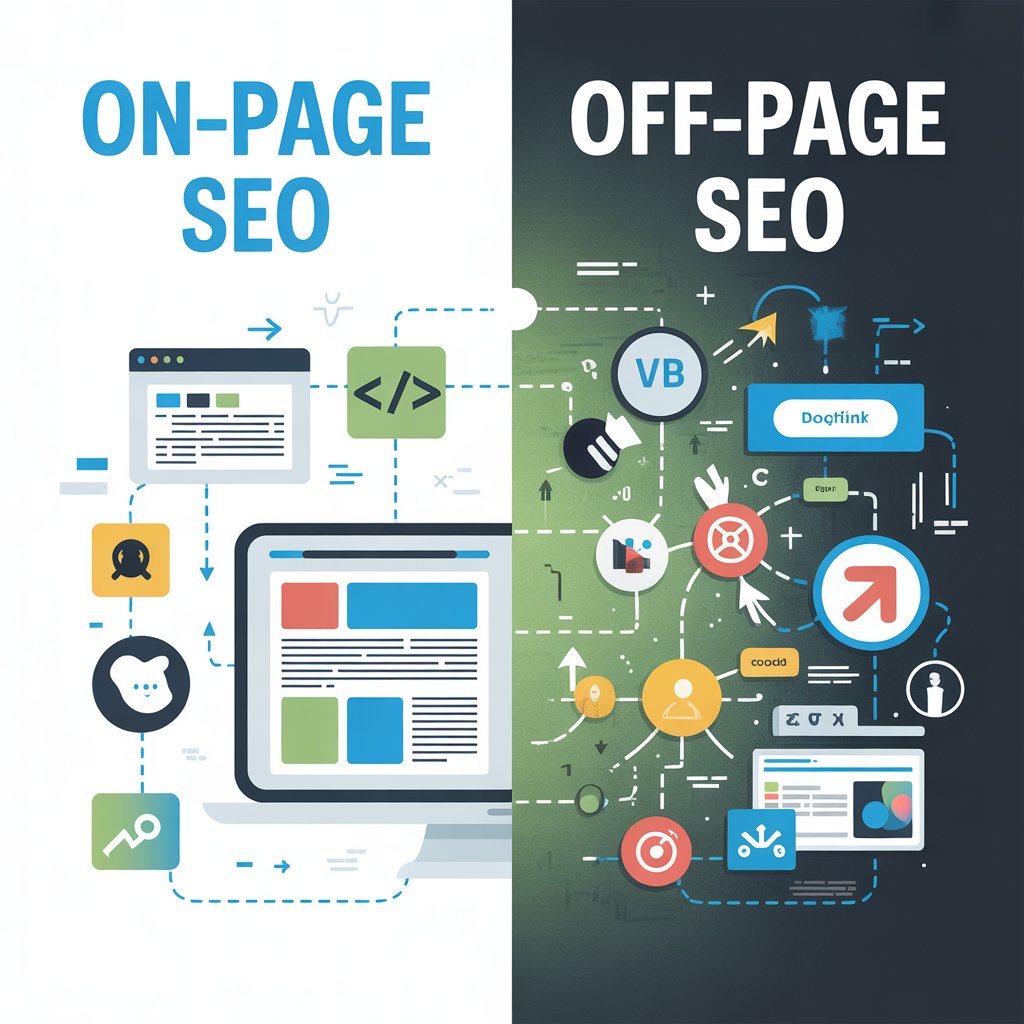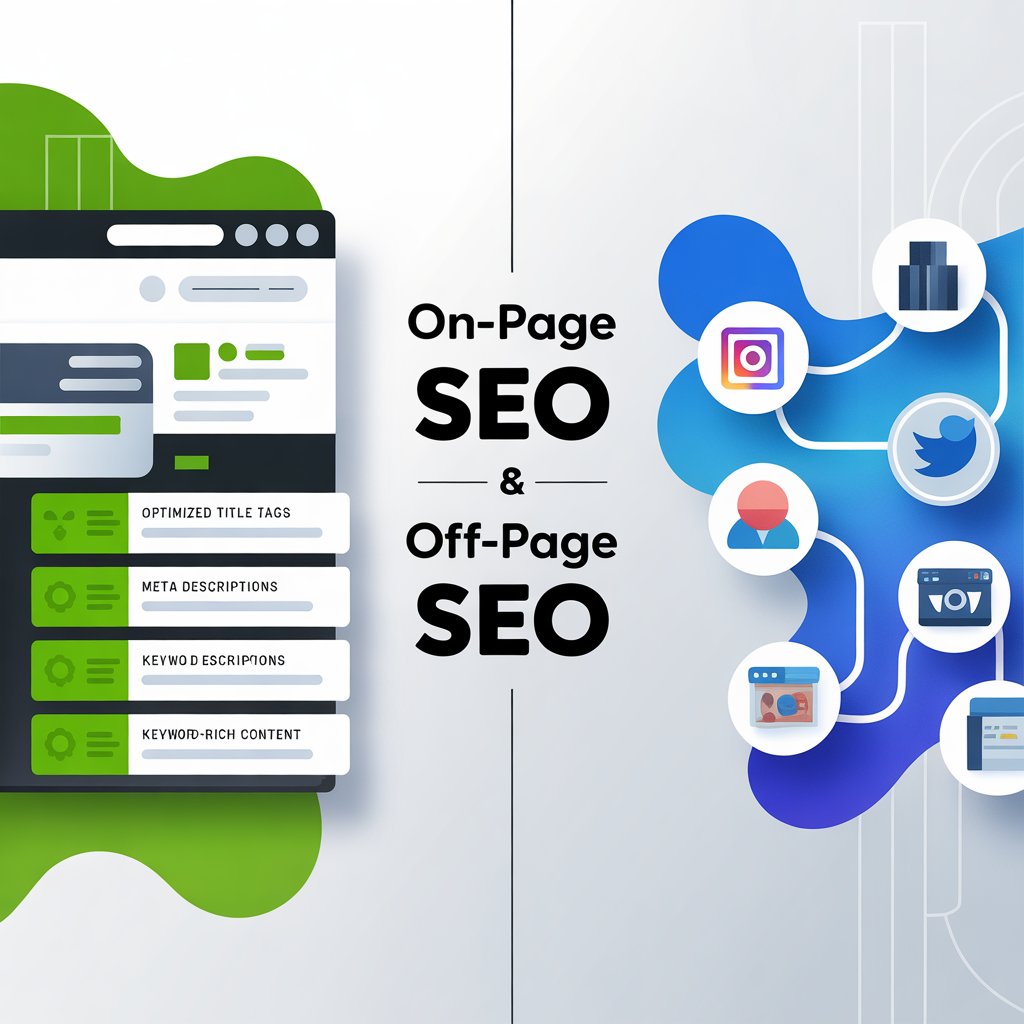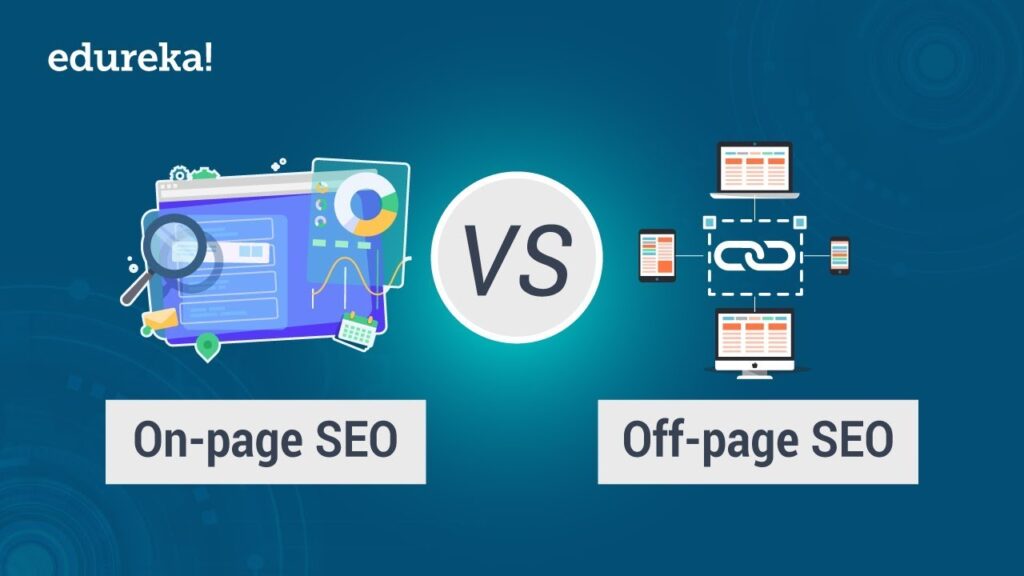Search Engine Optimization (SEO) is the backbone of digital marketing. To rank higher on search engines like Google, you need a strong on-page and off-page SEO strategy. While on-page SEO focuses on optimizing elements within your website, off-page SEO involves actions taken outside your site to improve its authority and relevance.
In this comprehensive guide, you’ll learn:
- The difference between on-page and off-page SEO
- Step-by-step strategies for both
- Best practices and common mistakes to avoid
- How to measure your success
By the end, you’ll have a clear roadmap to boost your website’s

1. Introduction to On-Page and Off-Page SEO
Search Engine Optimization (SEO) is the process of improving your website’s visibility on search engines like Google. SEO is divided into two main categories: on-page SEO and off-page SEO. Both are essential for achieving higher rankings, driving organic traffic, and growing your online presence.
- On-page SEO involves optimizing elements within your website, such as content, HTML tags, and site structure.
- Off-page SEO focuses on external factors, like backlinks, social signals, and brand mentions, that influence your site’s authority and trustworthiness.
In this comprehensive guide, you’ll learn:
- The difference between on-page and off-page SEO
- Actionable steps to optimize both
- Best practices and common pitfalls
- How to track your progress and measure success
By the end, you’ll have a clear, step-by-step roadmap to master on-page and off-page SEO and boost your website’s performance.
2. What is On-Page SEO? Key Elements and Best Practices
On-page SEO refers to all the optimizations you can perform directly on your website to improve its search engine rankings. It includes both the content and the HTML source code of your pages.
Key Elements of On-Page SEO:
- Content Quality: High-quality, original, and engaging content that answers user queries.
- Keyword Optimization: Strategic placement of focus keywords and related terms.
- Title Tags: Compelling and keyword-rich titles under 60 characters.
- Meta Descriptions: Informative and enticing snippets under 160 characters.
- Header Tags (H1, H2, H3): Properly structured headings for readability and SEO.
- URL Structure: Clean, descriptive, and keyword-rich URLs.
- Internal Linking: Linking to other relevant pages within your site.
- Image Optimization: Using alt text and compressing images for faster loading.
- Page Speed: Ensuring fast load times for better user experience and rankings.
Best Practices for On-Page SEO:
- Focus on User Intent: Create content that matches what users are searching for.
- Use LSI Keywords: Incorporate related terms and synonyms for better context.
- Optimize for Mobile: Ensure your site is responsive and mobile-friendly.
- Improve Readability: Use short paragraphs, bullet points, and subheadings.
3. Step-by-Step On-Page SEO Optimization Guide
Step 1: Conduct Keyword Research
Start by identifying the right keywords for your content. Use tools like Google Keyword Planner, Ahrefs, or SEMrush to find high-intent, low-competition keywords.
- Focus Keyword: “on page and off page”
- Related Keywords: on-page SEO techniques, off-page SEO strategies, SEO best practices 2025, how to improve on-page SEO, off-page SEO examples, on-page vs off-page SEO, SEO optimization guide
Step 2: Optimize Title Tags
Your title tag is one of the most important on-page SEO elements. It should be compelling, include your focus keyword, and be under 60 characters.
Example: “Master On-Page and Off-Page SEO: A Step-by-Step Guide for 2025”
Step 3: Craft Engaging Meta Descriptions
Meta descriptions appear in search results and influence click-through rates. Keep them under 160 characters and include your focus keyword.
Example: “Learn how to master on-page and off-page SEO with this step-by-step guide. Boost your rankings and drive more organic traffic in 2025!”
Step 4: Use Header Tags Effectively
Header tags help search engines understand the structure of your content. Use H1 for the main title and H2/H3 for subheadings.
Example:
- H1: Master On-Page and Off-Page SEO: A Step-by-Step Guide
- H2: What is On-Page SEO? Key Elements and Best Practices
- H3: Key Elements of On-Page SEO
Step 5: Create High-Quality, Keyword-Optimized Content
Write in-depth, informative content that answers user queries. Use your focus keyword naturally throughout the content, but avoid keyword stuffing.
- Content Length: Aim for at least 1,500 words for comprehensive guides.
- Keyword Density: Keep it around 1-2%.
- Readability: Use short paragraphs, bullet points, and subheadings for better engagement.
Step 6: Optimize Images for SEO
Images enhance user experience but can slow down your site if not optimized.
- Alt Text: Describe images using keywords (e.g., “on-page and off-page SEO infographic”).
- File Size: Compress images to improve page speed.
Step 7: Improve Page Speed
Page speed is a critical ranking factor. Use tools like Google PageSpeed Insights to identify and fix issues.
- Enable Caching: Use plugins like WP Rocket for WordPress.
- Minify CSS/JS: Reduce file sizes for faster loading.
- Use a CDN: Distribute content globally for quicker access.
Step 8: Implement Internal Linking
Link to other relevant pages on your site to improve navigation and distribute link equity.
Example: “For more on on-page SEO techniques, check out our guide on keyword optimization.”

4. What is Off-Page SEO? Why It Matters for Rankings
Off-page SEO refers to all the actions taken outside your website to improve its search engine rankings. The most important factor is backlinks, but it also includes social signals, brand mentions, and influencer marketing.
Key Elements of Off-Page SEO:
- Backlinks: High-quality links from authoritative and relevant websites.
- Social Signals: Shares, likes, and engagement on social media platforms.
- Brand Mentions: Unlinked mentions of your brand across the web.
- Guest Blogging: Writing articles for other websites to earn backlinks.
- Influencer Marketing: Collaborating with industry influencers to boost credibility.
Why Off-Page SEO Matters:
- Builds Authority: Backlinks from trusted sites signal to search engines that your content is valuable.
- Increases Visibility: Social shares and brand mentions expand your reach.
- Drives Traffic: Quality backlinks and social engagement bring more visitors to your site.
5. Step-by-Step Off-Page SEO Strategies for 2025
Step 1: Build High-Quality Backlinks
Backlinks are the foundation of off-page SEO. Focus on earning links from reputable, relevant websites.
- Guest Posting: Write articles for industry blogs and include a link back to your site.
- Broken Link Building: Find broken links on other sites and suggest your content as a replacement.
- Skyscraper Technique: Create better content than your competitors and reach out for links.
Step 2: Leverage Social Media for SEO
While social media doesn’t directly impact rankings, it drives traffic and increases brand visibility.
- Share Content: Post your articles on platforms like LinkedIn, Twitter, and Facebook.
- Engage with Followers: Respond to comments and encourage shares to boost engagement.
Step 3: Encourage Brand Mentions
Brand mentions, even without links, can improve your site’s authority and trustworthiness.
- Monitor Mentions: Use tools like Mention or Google Alerts to track when your brand is mentioned.
- Reach Out: Thank those who mention your brand and politely ask for a link if appropriate.
Step 4: Collaborate with Influencers
Influencers can help amplify your content and attract new audiences.
- Identify Relevant Influencers: Look for those in your niche with engaged followers.
- Build Relationships: Engage with their content before pitching collaborations.
Step 5: Submit to Directories and Listings
Submit your website to relevant directories to earn backlinks and improve visibility.
- Local Directories: Google My Business, Yelp, Bing Places.
- Industry Directories: Niche-specific listings and professional associations.
6. Common On-Page and Off-Page SEO Mistakes to Avoid
On-Page SEO Mistakes:
- Keyword Stuffing: Overusing keywords unnaturally in your content.
- Poor Content Quality: Publishing thin, duplicate, or irrelevant content.
- Ignoring Mobile Optimization: Not having a mobile-friendly or responsive site.
- Slow Page Speed: Not optimizing images, using caching, or minifying code.
Off-Page SEO Mistakes:
- Buying Backlinks: Purchasing low-quality, spammy links can hurt your rankings.
- Ignoring Social Media: Missing out on traffic and engagement opportunities.
- Not Monitoring Brand Mentions: Failing to capitalize on unlinked mentions or negative reviews.
7. How to Measure SEO Success: Tools and Metrics
Track your progress using tools like Google Analytics, Google Search Console, Ahrefs, and SEMrush.
Key Metrics to Monitor:
- Organic Traffic: Number of visitors coming from search engines.
- Keyword Rankings: Positions for your target keywords.
- Backlink Profile: Number and quality of backlinks pointing to your site.
- Bounce Rate: Percentage of visitors who leave without interacting.
- Conversion Rate: Percentage of visitors who complete a desired action (e.g., purchase, sign-up).
8. Conclusion: Your SEO Action Plan
Mastering on-page and off-page SEO is essential for improving your website’s visibility, driving organic traffic, and achieving long-term success. Here’s your action plan:
- Optimize On-Page Elements: Focus on content quality, keyword placement, meta tags, and site speed.
- Build High-Quality Backlinks: Use guest posting, broken link building, and influencer collaborations.
- Leverage Social Media: Share your content and engage with your audience.
- Monitor and Adjust: Track your metrics and refine your strategy based on data.
Start implementing these strategies today and watch your rankings and traffic grow!
What’s your biggest SEO challenge? Share your thoughts or contact us

